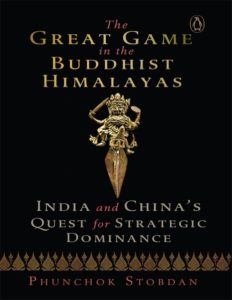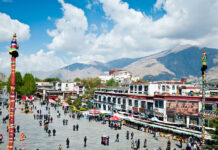Kunsang Thokmay* questions the expertise of Phunchok Stobdan whose recent comments on the Dalai Lama has triggered a major public controversy, including in his home Union Territory of Ladakh
(TibetanReview.net, Jun05’20)
Phunchok Stobdan, a former Indian ambassador based in Delhi, has accused the Dalai Lama of keeping silent on the Sino-Indian border dispute in Ladakh and speculated that he may be in collaboration with Communist China during an Aaj Tak TV interview on May 29. The allegation immediately sparked a public protest in Ladakh and Buddhist communities elsewhere. In the same interview, he also bashed the President of the Tibetan government in exile for provoking China by attending a Tibetan flag-raising ceremony in Ladakh, which the President never did.
This is a classic example of populist politicians appearing on TV channels or Social media nowadays to dramatically exaggerate sensitive issues with inaccurate and nationalistic mudslinging based on fear mongering and fabricated deception to serve self-interest. Do not get me wrong; if one has a coherent and sensible argument, of course, this is a free and democratic country.
Phunchok was, however, forced to apologise for what he has done. He suddenly softened his tone and said it was not meant to hurt anybody, including the Dalai Lama, and he excused that his baseless comments were due to his limited Hindi language vocabulary. Does this sound convincing? For the last more than 20 years of his political and diplomatic career, he published over a hundred articles and offensively, over and over again, blamed the Dalai Lama and the Tibetan refugees for disturbing Sino-Indian diplomacy and the peace and stability of the Himalayan regions. He intentionally fabricates conspiracy theories to disturb the harmony of Himalayan communities.
Relying on the Global Times, the mouthpiece of Chinese communist party, Phunchok even accused the Dalai Lama of receiving funding from China’s communist party officials and of shrewdly playing the Tawang card between China and India. Obviously, Phunchok did not want to talk about the fact that the Dalai Lama visited Tawang eight times to serve Indian political strategy. The Tibetan government in exile and the Dalai Lama publicly supported McMahon line and India’s claim over Arunachal Pradesh.
Truth be told, this is still only the tip of the iceberg of Phunchok ‘s hatred toward the Dalai Lama and Tibetan refugees in India. He compiled his revised old articles and converted them into a book with 16 chapters under the title of “The Great Game in the Buddhist Himalayas: India and China’s Quest for Strategic Dominance”. Like any other arrogant and ignorant politician, he blindly blabbers throughout the book to forge a conspiracy theory on treacherous information against Tibetans. For instance, Phunchok writes that Tibetan schools in India are teaching Tibetan history rather than emphasising on Indian history and literature.
Yes, of course, Tibetan schools do teach Tibetan history; that is the primary purpose of setting up separate Tibetan schools on the mutual agreement of the Dalai Lama and Jawaharlal Nehru. At the same time, Tibetan schools cover all the CBSE syllabuses and Tibetan students sit for CBSE examinations shoulder-to-shoulder with Indian students. How can one make such impulsive and unattested allegations?
Let’s forget to analyse his whole book, the first chapter, “A Profile of Himalayan Buddhism” is overloaded with more than 50 basic factual errors that even a high school student can easily spot out. I am talking about fundamental factual errors, not his distorted descriptions of Tibetan Buddhist schools and their linages because the mistakes are beyond the correctability. He, however, proudly claims for himself the title of being a well-known international strategic expert of Himalayan border issues. Thus, at least, we should expect that he knows the very basic historical backgrounds of the Himalayan culture and religion.
Have a look at some direct quoted examples from the first chapter of his book. Regarding the origin of the Sakya tradition in Himalayan regions, Phunchok writes, “After Sakya Pandita died in 1251, his son Dogon Chogyal Phagpa became the overlord of Tibet. In 1253, Kublai Khan invited Sakya Pandita’s nephew to become the religious patron of the Yuan Dynasty.” Mr expert event do not know that Sakya Pandita was a monk, and Phagpa was his nephew, not son, who was invited to become a religious priest, not a patron of the Yuan Dynasty.
Phunchok again says, “Lhazang was the grandson of Gushi Khan who had given the title of ‘Dalai’ to the Fifth Dalai Lama in 1641.” Excuse me. “Dalai Lama” is the title that was firstly conferred on the Third Dalai Lama by Altan Khan in 1578. Mr expert writes: “In 1686, Qusot Lhazang Khan found a monk from Kham, Ngawang Yeshe Gyatso, to be anointed as the ‘true’ Sixth Dalai Lama.” Really? You don’t know that this event occurred in 1706, not in 1686?
Again, he narrates: “The news immediately emerged that the Sixth Dalai Lama, Tsangyang Gyatso, had escaped from Lhazang Khan’s custody and had been living in Lithang in Kham.” That is again not true. The news that emerged was of the birth of the Dalai Lama’s reincarnation in Lithang in 1708, not Tsangyang’s escape. Indeed, Tsangyang Gyatso died en route to Peking in 1706; so, how could he have escaped to Lithang in 1708?
I can go on and on; but one might argue here that although Phunchok does not know the history of Tibet, he is an expert on Ladakh. If that is so, let us see his narratives of Ladakh’s history.
To explain the origin of Ladakh’s dynasty, Phunchok writes, “Nyimagon settled in maryul (the original name of Ladakh) and married the daughter of a local chieftain of the Thi Dynasty, Tashitsen.” None of the primary materials has this narrative at all. Nyimagon was a Tibetan prince who fled to Ladakh and married two daughters of his two ministers Nyang Patsab and Jokro Lekdra, both of whom had escaped with him. The latter gave birth to three sons.
Again, regarding the Tibet-Ladakh war in the 1670s, he claims that the Tibetan “goal was to bring all Himalayan states into the Gelugpa fold.” This is the backbone of Phunchok ‘s lifetime argument; but none of the first-hand materials support his assertion. Tibet launched a war against Ladakh for two reasons: Ladakh had invaded a vast territory of upper Tibet while Tibet was plunged in a civil war. Secondly, the people of Guge had repeatedly requested Lhasa to do it.
Phunchok again writes, “It is said that the Ladakh–Bhutan axis prompted the Fifth Dalai Lama to once again stage a brutal attack on Ladakh in 1684 with the help of reinforcement from the Zungar Mongols. By then, the Mughals withdrew support to the Ladakh king after being paid off by the Fifth Dalai Lama.” Here, he attached two events to the Fifth Dalai Lama, but the fact is the Fifth Dalai Lama had died in 1682, two years before this event.
I do not want bother to go on to correct his whole book; it makes me feel as if I am a primary school teacher checking a students’ history homework. I also do not want to waste my time to analyse his other arguments, because this whole ignorant conspiracy theory has been built on these false histories and self-fabrication. I cannot imagine how he dared to still call himself an expert with more than 30 years of knowledge.
If one has time to browse through his bibliography of the book, most of his trusted sources are China daily, Global Times, Xinhua News and China-Tibet News, among others. He is still accusing others of having Chinese influence. Moreover, I cannot believe that Vintage and Penguin Random House has published such a trashy work without checking the very basic factual errors.
The lifetime efforts of Phunchok Stobdan to rent the popularity of the Dalai Lama and Tibetan refugees in India have, in fact, nothing to do with Indian geopolitical strategy and Sino-Indian border stability whatsoever. Reading his articles, we can clearly see that Phunchok has still been stuck in the 18th century with a tremendous historical hatred toward Tibetans, especially the Gelugpa school that began to spread in the Himalayan regions through the Gaden Phodrang government. He himself admitted that he absolutely disliked the fact that Gelugpa was becoming popular in Himalayan regions through the Dalai Lama and other Gelugpa refugee Lamas and claims that Gelugpa is the source of instability in Himalayan regions. Does it really sound like a strategist expert? I think it is absolutely ridiculous.
Phunchok ‘s accusations against Tibetan Buddhist schools are, of course, selective and purposely crafted based on his hidden agenda. For a person claiming expertise as a political strategist, to play with religious sentiments for one’s own religious priority is very destructive. If there are some threats to the peace and stability of Himalayan regions, it is his kind of false statements and conspiracy theories which could become the underlying cause. Phunchok ‘s recent offensive political comedy show on Aaj Tak TV is a living example of this.
—
* Kunsang Thokmay (aka Darig Thokmay) is a PhD scholar in Oriental Studies at Oxford University and also works as an assistant researcher at Oxford Socio-legal Studies and the Faculty of Linguistics, Philology and Phonetics. Thokmay writes for both academic and general audiences on various topics. His works have appeared on Asia Times, Times of India, Asian Affairs and The Telegraphy, among others.








